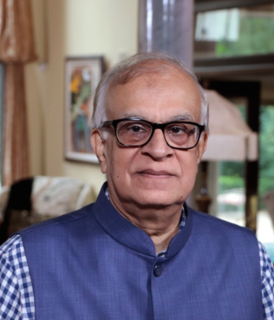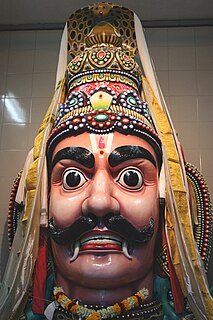Related Research Articles

The Kama Sutra is an ancient Indian Sanskrit text on sexuality, eroticism and emotional fulfillment in life. Attributed to Vātsyāyana, the Kama Sutra is neither exclusively nor predominantly a sex manual on sex positions, but rather was written as a guide to the art of living well, the nature of love, finding a life partner, maintaining one's love life, and other aspects pertaining to pleasure-oriented faculties of human life. It is a sutra-genre text with terse aphoristic verses that have survived into the modern era with different bhāṣyas. The text is a mix of prose and anustubh-meter poetry verses. The text acknowledges the Hindu concept of Purusharthas, and lists desire, sexuality, and emotional fulfillment as one of the proper goals of life. Its chapters discuss methods for courtship, training in the arts to be socially engaging, finding a partner, flirting, maintaining power in a married life, when and how to commit adultery, sexual positions, and other topics. The majority of the book is about the philosophy and theory of love, what triggers desire, what sustains it, and how and when it is good or bad.
Shruti in Sanskrit means "that which is heard" and refers to the body of most authoritative, ancient religious texts comprising the central canon of Hinduism. Manusmriti states: Śrutistu vedo vijñeyaḥ meaning, "Know that Vedas are Śruti". Thus, it includes the four Vedas including its four types of embedded texts—the Samhitas, the Upanishads, the Brahmanas and the Aranyakas.
Smriti, literally "that which is remembered" are a body of Hindu texts usually attributed to an author, traditionally written down, in contrast to Śrutis considered authorless, that were transmitted verbally across the generations and fixed. Smriti is a derivative secondary work and is considered less authoritative than Sruti in Hinduism, except in the Mimamsa school of Hindu philosophy. The authority of smriti accepted by orthodox schools, is derived from that of shruti, on which it is based.
Indology, also known as South Asian studies, is the academic study of the history and cultures, languages, and literature of the Indian subcontinent, and as such is a subset of Asian studies.

Wendy Doniger O'Flaherty is an American Indologist whose professional career has spanned five decades. A scholar of Sanskrit and Indian textual traditions, her major works include, 'The Hindus: an alternative history'; Asceticism and Eroticism in the Mythology of Siva; Hindu Myths: A Sourcebook; The Origins of Evil in Hindu Mythology; Women, Androgynes, and Other Mythical Beasts; and The Rig Veda: An Anthology, 108 Hymns Translated from the Sanskrit. She is the Mircea Eliade Distinguished Service Professor of History of Religions at the University of Chicago, and has taught there since 1978. She served as president of the Association for Asian Studies in 1998.
Jeffrey John Kripal is an American college professor. He is the J. Newton Rayzor Chair in Philosophy and Religious Thought at Rice University in Houston, Texas.
S. N. Balagangadhara is a professor emeritus of the Ghent University in Belgium, and was director of the India Platform and the Research Centre Vergelijkende Cutuurwetenschap.
Katherine K. Young is a Canadian religious studies professor at McGill University. Originally a scholar of Hinduism, in later life her interests have turned to the topic of misandry.

Indra's Net: Defending Hinduism's Philosophical Unity is a 2014 book by Rajiv Malhotra, an Indian-American author, philanthropist and public speaker, published by HarperCollins.

Anantanand Rambachan is a professor of religion at St. Olaf College.

Kali's Child: The Mystical and the Erotic in the Life and Teachings of Ramakrishna is a book on the Indian mystic Ramakrishna by Hindu studies scholar Jeffrey J. Kripal, published in 1995 by the University of Chicago press. It argues for a homoerotic strain in Ramakrishna's life, rituals, and teachings.

Rajiv Malhotra is an Indian-born American Hindutva activist, author and founder of Infinity Foundation, which focuses on Indic studies, and also funds projects such as Columbia University's project to translate the Tibetan Buddhist Tengyur.
Ramakrishna (1836–1886) was a 19th-century Indian mystic whose teachings form the foundation of the Ramakrishna religious movement, Ramakrishna Order and Ramakrishna Mission.

In Hinduism, Brahman connotes the highest universal principle, the ultimate reality in the universe. In major schools of Hindu philosophy, it is the material, efficient, formal and final cause of all that exists. It is the pervasive, infinite, eternal truth, consciousness and bliss which does not change, yet is the cause of all changes. Brahman as a metaphysical concept refers to the single binding unity behind diversity in all that exists in the universe.

LGBT themes in Hindu mythology involve Hindu deities or heroes whose attributes or behavior can be interpreted as lesbian, gay, bisexual, transgender, or as having elements of gender variance and non-heterosexual sexuality. Traditional Hindu literary sources do not speak of homosexuality directly, but changes of sex, homoerotic encounters, and intersex or third gender characters are often found both in traditional religious narratives such as the Vedas, Mahabharata, Ramayana and Puranas as well as in regional folklore.

Invading the Sacred: An Analysis of Hinduism Studies in America is a book published in 2007 by Rupa & Co. which argues that there are factual inaccuracies in Hindu studies. The editors of the book are Krishnan Ramaswamy, Antonio T. de Nicolás, and Aditi Banerjee. The book has contributions from Arvind Sharma of McGill University, S. N. Balagangadhara of Ghent University, psychoanalyst Alan Roland, Yvette Rosser, Ramesh N. Rao, Pandita Indrani Rampersad, Yuvraj Krishnan, and others. Rajiv Malhotra played a large role in drafting most of the book's content. He stated that through this book, he intended to bring attention to, and provide a counter-argument to, the prevalent Freudian psychoanalytical critiques of Hinduism in the American Academy of Religion's RISA group. After the controversy surrounding Wendy Doniger's book The Hindus: An Alternative History erupted in India, the authors decided to make it freely available online as it critiques a major part of her work.

Neo-Vedanta, also called Hindu modernism, neo-Hinduism, Global Hinduism and Hindu Universalism, are terms to characterize interpretations of Hinduism that developed in the 19th century. The term "Neo-Vedanta" was coined by German Indologist Paul Hacker, in a pejorative way, to distinguish modern developments from "traditional" Advaita Vedanta.

Being Different: An Indian Challenge to Western Universalism is a 2011 book by Rajiv Malhotra, an Indian-American author, philanthropist and public speaker, published by HarperCollins. The book reverts the gaze of the western cultures on India, repositioning India from being the observed to the observer, by looking at the West from a Dharmic point of view.

The Battle for Sanskrit: Is Sanskrit Political or Sacred, Oppressive or Liberating, Dead or Alive? is a 2016 book written by Rajiv Malhotra which criticizes the work of the American indologist Sheldon Pollock. Malhotra pleads for traditional Indian scholars to write responses to Pollock's views.
David Gordon White is an American Indologist.
References
- ↑ Alles, Gregory D. (1 January 2008). Religious Studies: A Global View. Routledge. ISBN 9780415397438 – via Google Books.
- ↑ Brian Kemble Pennington, Was Hinduism Invented?. New York: Oxford University Press, 2005. p. 3-4
- ↑ Wendy Doniger. "Hinduism by Any Other Name Archived 30 December 2021 at the Wayback Machine ". Wilson Quarterly 15.3 (1991).
- ↑ "Institutions that may be operating illegally in South Carolina Or operating illegally elsewhere and enrolling residents of South Carolina (updated 03/04/2014)" (PDF). South Carolina Commission on Higher Education. Archived from the original (PDF) on 6 June 2014. Retrieved 3 June 2014.
- ↑ Arti Dhand. "Hinduism to Hindus in the Western Diaspora." Method & Theory in the Study of Religion 17.3 (2005).
- ↑ "Kali's Child".
- 1 2 Balagangadhara, S.N.; Sarah Claerhout (Spring 2008). "Are Dialogues Antidotes to Violence? Two Recent Examples From Hinduism Studies" (PDF). Journal for the Study of Religions and Ideologies. 7 (19): 118–143. Archived from the original (PDF) on 20 August 2009. Retrieved 5 June 2010.
- ↑ Paul B. Courtright. "The Self-Serving Humility of Disciplining Liberal Humanist Scholars". Journal of the American Academy of Religion 74.3 (2006), 752-755
- 1 2 Amy M. Braverman. "The interpretation of gods" Archived 31 May 2012 at the Wayback Machine . University of Chicago Magazine, 97.2 (December 2004).
- 1 2 Sharma, Arvind (Spring 2004). "Hindus and Scholars". Religion in the News. Trinity College. 7 (1). Archived from the original on 11 May 2010. Retrieved 7 June 2010.
- 1 2 Kurien, Prema (2007). A place at the multicultural table: the development of an American Hinduism. Rutgers University Press. p. 202. ISBN 9780813540566.
- ↑ Martha C. Nussbaum, The Clash Within: Democracy, Religious Violence, and India's Future (Cambridge, MA: Harvard University Press, 2009), p. 248
- ↑ "About the Contributors". Archived from the original on 14 July 2012. Retrieved 7 June 2010.
- ↑ Rambachan, Anantanand (April 2008). "Hindu Studies". International Journal of Hindu Studies . 12 (1): 81–101. doi:10.1007/s11407-008-9055-y.
- ↑ Shrinivas Tilak. "Taking Back Hindu Studies" Archived 21 January 2008 at the Wayback Machine . In John Stratton Hawley and Vasudha Narayanan, eds., The Life of Hinduism. University of California Press, 2006.
- ↑ Russell T. McCutcheon. "It's a Lie. There's No Truth in It! It's a Sin!": On the Limits of the Humanistic Study of Religion and the Costs of Saving Others from Themselves. Journal of the American Academy of Religion 74.3 (2006), 747
- ↑ McCutcheon 2006, 736
- ↑ McCutcheon 2006, 729-730
- ↑ "Invading The Sacred".
- ↑ WC Smith. "Comparative religion: whither--and why?" In Eliade and Kitagawa, The History of Religions. Chicago: University of Chicago, 1959.
